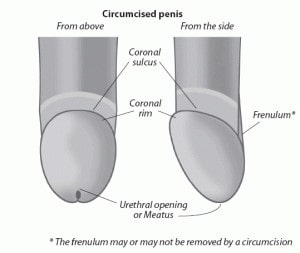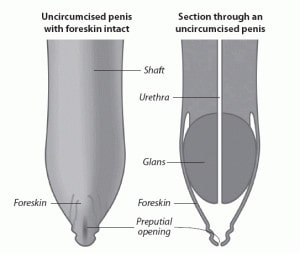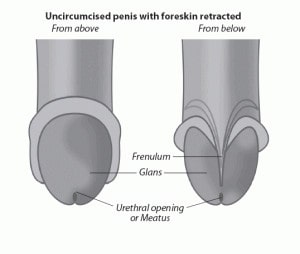Circumcision
What is Circumcision?
Circumcision is a simple surgical procedure that removes the foreskin – a sleeve of skin covering the tip of the penis. In order to make an informed decision, they must carefully consider the benefits and risks.
Benefits of Circumcision
- Eliminates the risk of phimosis, which affects 1 in 10 older boys and men. This condition refers to a tight foreskin that cannot be pulled back fully, so making cleaning under it, and passing urine, difficult.
- Reduces by 3-fold the risk of inflammation and infection of the skin of the penis. One in 10 uncircumcised men gets inflammation of the head of the penis and foreskin.
- Over 10-fold decrease in risk of urinary tract infection. Whereas risk of this is only 1 in 500 for a circumcised boy, 1 in 50 uncircumcised male infants will get a urinary tract infection.
- Over 10-20-fold decrease in risk of invasive penile cancer which usually requires penile amputation or disfiguring surgery.
- Uncircumcised men may be associated with a higher risk (1½ – 2x) of prostate cancer, which affects 1 in 6 men.
- Reduces by approximately 3 to 7 fold the risk of getting HIV (AIDS), during sex with an infected person.
- Circumcision also affords substantial protection against thrush as well as sexually transmitted infections such as human papilloma (wart) virus (HPV) and syphilis.
- Circumcision reduces by up to 5 times the risk of the man’s female partner being infected by Chlamydia or getting cervical cancer (which is caused by HPV). The load of infectious bacteria and viruses that accumulate under the foreskin is delivered into the female genital tract during sex.
- If not circumcised soon after birth, up to 5-10% will later require one for medical reasons.
- In general, sexual function would be the same or better in circumcised men. The problem of overly tender sensitivity of the head of the penis (possible cause of premature ejaculation) experienced by most uncircumcised men is often improved.
- Cosmesis – some men or their partner may prefer the appearance of circumcised penis.



What are the Risks of Circumcision?
- For 1 in 500 circumcisions, there may be either a little bleeding – easily stopped by pressure or, less commonly, requiring stitches (1 in 1000); the need for repeat surgery (1 in 1000); or a generalised infection that will require antibiotics (1 in 4000). Although there can be a local infection, often what seems like a local infection is actually part of the normal healing process.
- Serious complications (requiring hospitalisation) are rare – approximately 1 in 5000.
- Mutilation or loss of the penis, and death, are virtually unheard of with circumcisions performed by a competent medical practitioner.
If you need circumcision in Sydney, contact Advanced Urology now!
